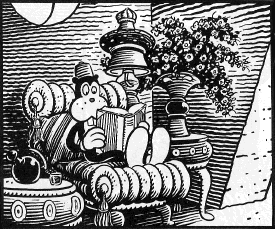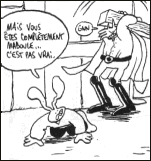

| February 1999 |
|
| Jim Woodring: Jim and Frank | |
Let's start with Woodring's own simultaneously accurate and hilarious self-assessments of two of his books:
The Book of Jim: This is the one book I refuse to be buried with, now in its second big printing. It contains all the most baffling, creepy, and unintentionally revealing autobiographical and delusional material from the ultra-scarce first four issues of Jim vol.1.Frank: 96 pages of Frank! Think of it! Think long and hard. Now give up and buy the book, which exceeds in ingenuity whatever you just imagined. Not just a bunch of nonsense, but clever, relevant fables that have deep meaning and can improve your life!
 What, as Mark Martin complains in his introduction to The Book of Jim, can one add to that? Jim largely consists of retellings of Woodring's dreams; the Frank books (and more recently the Frank comic) spin wordless tales of Frank, who looks like a '20s animated cartoon character and lives in a surreal landscape filled with numinous paraphernalia, unearthly architecture, nameless horrors, and sudden epiphanies.
What, as Mark Martin complains in his introduction to The Book of Jim, can one add to that? Jim largely consists of retellings of Woodring's dreams; the Frank books (and more recently the Frank comic) spin wordless tales of Frank, who looks like a '20s animated cartoon character and lives in a surreal landscape filled with numinous paraphernalia, unearthly architecture, nameless horrors, and sudden epiphanies.
Woodring strikes me as perhaps the only cartoonist who successfully captures a religious point of view. Don't worry, he doesn't try to convert you; it's not even clear what religion it is... probably some kind of Hinduism... not that it matters.
I can hear most of you saying, "This is a good thing?" Well, yes, because the depiction of human experience is one of the great capabilities of art, and this kind of experience is almost never captured well. There are plenty of attempts to capture Christian doctrine, each more moralistic than the last. And there are stories about religion, such as Dave Sim's Church & State, or even Rick's Story. But these leave unplumbed what should be the central mystery, even or perhaps especially for unbelievers: what it feels like to be a believer; what could possibly be attractive-- or inescapable-- about belief.
Ultimately this is-- though different doctrines will state it and theologize it very differently-- about encountering mystery, about a sense of the world opening up and something else shining through, something inexplicable and momentous. More than half the time, in Woodring (especially in the Frank stories), the emotion evoked is horror. Or rather, what used to be called horror, before the word was debased by an endless series of gross-out movies.
Some may be surprised to hear that horror is a religious emotion. We're used to saccharine depictions of religion-- Grandpa Keane hanging around as a benevolent transparency-- and to hearing religion explained away as wish-fulfillment. But if it's wish-fulfillment, it's fear-fulfillment as well; and religious feeling is full of horrors as well: the horror of evil, of sin, of hell; the wrath of God; the brutalities inflicted by human beings upon each other. (The Bible is full of things-- sex, murder, tortures, doubt, drunkenness, witches-- that fundies complain about finding anywhere else.) Real religions pay attention to these things-- and also balance or redeem them with ecstasies, joys, and poetic splendors. Compared with atheism, a living, religious point of view is above all rich-- emotionally exhausting, full of vertiginous upward and downward views. You would never learn this from Dave Sim (or Bil Keane).
Now, you may not get all of that out of Jim Woodring at all. It's there, but you may get something else that's also there. Woodring raises questions without necessarily answering them, and you can read the stories again and again, as you can stare at a burning fire or read Shakespeare, without ever being able to say that you've got it all down. Take the back cover blurbs on Frank vol. 1: Scott McCloud thinks Woodring is important; Bill Griffith finds him chilling; Neil Gaiman emphasizes that he's fun. None of them are wrong.
As for the art, Woodring produces some of the most gorgeous stuff out there. Usually it's in black & white, drawn with a distinctive wavy line that helps create Woodring's atmosphere of shimmering ominousness. In his color work Woodring can approach an almost photorealistic lifelikeness. A particular treat are his machines, houses, monsters, and angels; it's as if he's brought these back from an unknown culture, with its own assured, curvy aesthetic.
On a lighter note, don't miss the house ads (usually re-written each issue), or the descriptions of 'Jimland Novelties', odd artefacts lovingly handcrafted by Jim, and even the lettercol and comics recommendations. You might expect from his comics that Jim would be a rather disturbed individual-- and he tells of terrifying a couple of psychoanalysts by showing them his comics-- but the persona that emerges from these ephemera is too full of humor and generosity to be such a neurotic. How can you resist anyone who announces a price increase this way:
Attention! The price of paper has made an astonishing upward leap, forcing Fantagraphics to take the drastic measure of raising the rice of JIM. The next issue will therefore cost $3.50. To compensate, JIM will no longer be a comic book, but cartoon literature. If we are forced to raise the price again, we promise that JIM will become Belles Images to justify the additional cost. But really... 55c. Pif!
| Lewis Trondheim: The Spiffy Adventures of McConey | |
 Trondheim has an unusual range-- he does experimental comics, autobiographical comics, urban comedies, fantasies, and ciel knows what else. What's appeared in English is a one-shot called The Nimrod, two books of the McConey series, and a piece in Beto Hernandez's new all-ages comic, Measles (and that, by the way, with other contributors including Woodring and Beto, is definitely a book to follow). You can also try out the wordless La Mouche, a slice of life story about a fly.
Trondheim has an unusual range-- he does experimental comics, autobiographical comics, urban comedies, fantasies, and ciel knows what else. What's appeared in English is a one-shot called The Nimrod, two books of the McConey series, and a piece in Beto Hernandez's new all-ages comic, Measles (and that, by the way, with other contributors including Woodring and Beto, is definitely a book to follow). You can also try out the wordless La Mouche, a slice of life story about a fly.
Where was I? Ah yes, McConey. I can't quite deal with that translation of Lapinot, just as I can't deal with Snowy for Milou. Anyway, McConey/Lapinot is more or less the Pogo in Trondheim's animal cast. He's decent, agreeable, and excruciatingly timid with women (well, it's a female mouse named Nadia he's after, but you get the idea). His friend Richard, by contrast, is cocksure, excitable, and none too scrupulous, the sort of friend who's a pain in real life but adds life to comics.
The Lapinot stories are a curious mixture of urban comedy and fantasy; The Hoodoodad (Pichenettes), for instance, is both the story of an obscure Eastern European curse which may have fallen on Richard, and the low-key doings of a group of twentysomething friends in Paris. Blacktown, however, places the same characters in the 19th century American West, where they seem quite at home.
And Mildiou puts them in the Middle Ages, where Richard (as the tyrant Mildiou) spends 140 pages trying to kill Lapinot; most of the humor here consists of Lapinot's very modern attitudes towards the crazy stock-medieval characters he trips over (As Mildiou pursues him brandishing a beam to cave in his head: "Maybe you had some infantile disturbances which make you act like that. Talk to me about all that").
Trondheim's art is cartoony-- Lapinot is not much more than a smiley face with buck teeth-- but meets the demands put on it, and anyway, everything looks better in the rich, subtle colors of French comics.
I'm not put off by animal comics, but there is something about them that defies logic, rather like the humanoid aliens of sf shows and comics. In Lapinot, for instance, there are dog characters, and also pet dogs; duck characters, and chicken dinners. (And yet, in a shocking departure from comic animal tradition, Lapinot and friends don't have tails.)
Perhaps the best Trondheim yet is the Donjon series (done in collaboration with Joann Sfar). It's set in-- wait for it-- a dungeon, of the sort which will be familiar to any D&D fan. In the first album, Coeur de Canard [Duck Heart], the dungeon's Guardian has his chief reptile, Marvin, find a promising barbarian in the dungeon to carry out a delicate mission. Through a stupid mistake the barbarian is killed instead, and a duck named Herbert presents himself in his place. Herbert approaches his task with alternate bursts of baseless self-confidence and complete cowardice, and forges an unlikely alliance with the reptile.
Why hasn't Trondheim taken off in the U.S.? Flipping through one of his books, you're sure to notice the simple drawing and the animals, and from that, a lot of Americans are going to figure it's not worth reading. Comics for adults, you know, should look like Jack Kirby, or at least R. Crumb. If you feel that way, get over it, and give Trondheim a try.
Update (August 2006): Donjon is now appearing in English, as Dungeon. So if you are not reading this, you suck.
